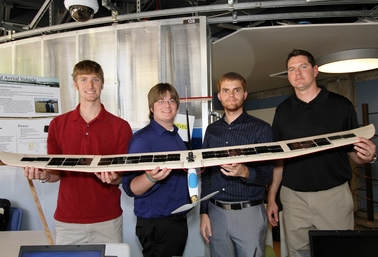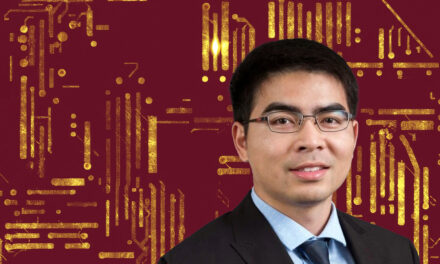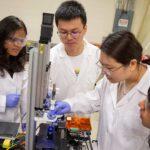
Engineering students tackle solar-powered flight challenges
Posted: July 08, 2011

ASU students (from left) Cory Peterson, Michael Yach, Mark Garrison and Cameron Simoes display the solar-airplane model that won them the top electrical engineering senior-year design project award for the 2010-2011 school year. Photo by: Jessica Slater
Arizona State University electrical engineering students are taking on the technological challenges of making solar-powered aircraft a more feasible flight option.
Two teams began the effort for their senior-year engineering design projects, building small-scale prototypes of remote-controlled airplanes powered by solar-cell technology that converts sunlight to electrical energy.
The seven students worked on extending the flight times of their airplanes and improving autopilot capability.
They experimented with mounting more solar cells on the planes to boost power – but without burdening the aircraft with additional weight of heavy batteries that would inhibit flight performance.
They sought ways to use excess solar-generated energy to charge the airplanes’ batteries, and to equip the planes with wireless communications capabilities such as global positioning devices and video technology to enable streaming of live images during flight.
“These teams have achieved truly amazing things,” says Yong-Hang Zhang, an electrical engineering professor who initiated the projects and advised the teams.
“Their designs are way beyond my original expectation,” Zhang says, “and I’m very pleased that our industrial collaborator, Boeing Spectrolab, has been so impressed by the students’ designs that the company has donated more than 300 high-efficiency solar cells for these projects.”
The teams’ promising advances prompted Stephen Phillips, director of the School of Electrical, Computer and Energy Engineering, to provide the students lab space in one of the engineering schools’ facilities.
In addition, Science Foundation Arizona is providing the projects some funding through its support of a program led by Zhang’s research group to develop improved high-efficiency solar cells.
The solar airplane team of Mark Garrison, Cory Peterson, Michael Yach and Cameron Simoes took the top electrical engineering senior design project award for the 2010-2011 academic year.
“Their project was one of the best I have seen in almost 10 years of coordinating our program’s senior design sequence,” said James Aberle, an associate professor of electrical engineering. He teaches the senior design course taken by members of both solar airplane teams.
The projects didn’t stop with the end of the recent spring semester. Students continue to work on the planes’ designs and conduct test flights to try to add more functions to the aircraft.
The two teams will pass the knowledge and skills they’ve gained on to some of next year’s senior-year engineering design project teams to give them a jump-start on pursuing additional technological advances.
More progress could help push solar-powered aircraft toward viable commercialization, boosting the potential for such planes to aid many public services.
Improved remote-controlled and autonomous (self-directed) aircraft can benefit law enforcement, border patrol and emergency-response operations, as well as environmental research and land protection efforts. The technology could also be useful to industry –particularly power companies and other utility operations.
“We have ambitious goals,” says student Borna Emami. “We intend to keep research and development going through future design teams and maybe even an ongoing solar-power flight club.”
Emami recently gave a presentation on his team’s solar-powered plane to a panel of prominent scientists and engineers from the Canada, Germany and the United States at a Science Foundation Arizona review session for Zhang’s solar-cell research program.
“They were all very much impressed,” Zhang reports. Emami “successfully demonstrated the autonomous control of the airplane. It worked exactly as we had planned.”
The electrical engineering students are looking to broaden the range of expertise on future teams by recruiting aerospace engineering students to join them.



































